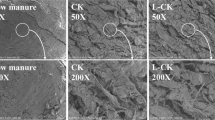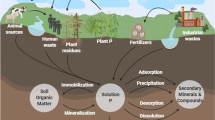Abstract
Introduction
Dissolved organic matter (DOM) is the most active component in environmental system and its chemical and structural characteristics most likely influence its biodegradation. Four surface soil (0–20 cm) and three core sediment samples (0–10 cm) were collected from Wuliangsuhai Lake. The objectives of this study were to investigate the spectral properties and humification degree of DOM and to determine and discuss comparatively the complexing capacities and stability constants of DOM by Cu (II) in the Hetao region.
Materials and methods
In this study, fluorescence spectra and fluorescence quenching methods were used to evaluate the humification degree of DOM and calculate the complexing capacities and the stability constants between DOM and Cu (II).
Results and discussion
Two defined peaks, at wavelengths of 260∼300 nm (peak I) and 300∼350 nm (peak II), could be identified for soil DOM at a Δλ value of 30 nm. In sediment DOM extracts, a third peak (III) was observed near 364 nm. The results show that there is a significant difference in the structure of DOM because of different sources. The humification degree is significantly higher for soil samples than those of sediment samples. The FT-IR spectra of DOM show that structure in sediment DOM is more functional groups than those in soil DOM. DOM has a stronger Cu binding affinity in soils than in sediment in the Hetao region, which may lead to potentially significant influence on the migration and transformation of Cu (II).




Similar content being viewed by others
References
Aldrich AP, Kistler D, Sigg L (2002) Speciation of Cu and Zn in drainage water from agricultural soils. Environ Sci Technol 36:4824–4830
Barber LB, Leenheer JA, Noyes TI, Stiles EA (2001) Nature and transformation of dissolved organic matter in treatment wetlands. Environ Sci Technol 35:4805–4816
Bolan NS, Adriano DC, Mahimairaja S (2004) Distribution and bioavailability of trace elements in livestock and poultry manure by-products. Crit Rev Environ Sci Technol 34:291–338
Brandt KK, Holm PE, Nybroe O (2008) Evidence for bioavailable copper dissolved organic matter complexes and transiently increased copper bioavailability in manure-amended soils as determined by bioluminescent bacterial biosensors. Environ Sci Technol 42:3102–3108
Camobreco VJ, Richards BK, Stenhuis T, Peverly JH, McBride MB (1996) Movement of heavy metals through undisturbed and homogenized soil columns. Soil Sci 161:740–750
Dudal Y, Holgado R, Maestri G, Guillon E, Dupont L (2006) Rapid screening of DOM’s metal-binding ability using a fluorescence based microplate assay. Sci Total Environ 354:286–291
Elkins KM, Nelson DJ (2001) Fluorescence and FT-IR spectroscopic studies of Suwannee river fulvic acid complexation with aluminum, terbium and calcium. J Inorg Biochem 87:81–96
Fukushima M, Tanaka S, Nakayasu K, Sasaky K, Nakamura H, Tatsumi K (1997) Investigation of copper (II)-binding behaviour of fulvic acids by three-dimensional fluorescence spectrometry. Anal Sci 13:1011–1015
Glaus MA, Baeyens B, Lauber M, Rabung T, Van Loon LR (2005) Influence of water-extractable organic matter from Opalinus Clay on the sorption and speciation of Ni(II), Eu(III) and Th(IV). App Geochem 20:443–451
Guo XJ, Xi BD, Yu HB, Ma WC, He XS (2011) The structure and origin of dissolved organic matter studied by UV–vis spectroscopy and fluorescence spectroscopy in lake in arid and semi-arid region. Water Sci Technol 63:1010–1017
He X, Xi B, Wei Z, Guo X, Li M, An D, Liu H (2011) Spectroscopic characterization of dissolved organic matter during composting of municipal solid waste. Chemosphere 82:541–548
Heijerick DG, van Sprang PA, van Hyfte AD (2006) Ambient copper concentrations in agricultural and natural European soils: an overview. Environ Toxicol Chem 25:858–864
Hur J, Lee B (2011) Characterization of binding site heterogeneity for copper within dissolved organic matter fractions using two-dimensional correlation fluorescence spectroscopy. Chemosphere 83:1603–1611
Jiang J, Yu H, Xi B, Guo X, Zhou Y, Liu H (2010) Characterization of dissolved organic matter in saline soil in Hetao irrigation district, China by fluorescence spectroscopy. Fresen Environ Bull 19:963–971
Kalbitz K, Geyer W, Geyer S (1999) Spectroscopic properties of dissolved humic substances—a reflection of land use history in a fen area. Biogeochemistry 47:219–238
Kanokkantapong V, Marhaba TF, Panyapinyophol B, Pavasant P (2006) FTIR evaluation of functional groups involved in the formation of haloacetic acids during the chlorination of raw water. J Hazard Mater 136:188–196
Kim HC, Yu MJ (2005) Characterization of natural organic matter in conventional water treatment processes for selection of treatment process focused on DBPs control. Water Res 39:4779–4789
Knoth de Zarruk K, Scholer G, Dudal Y (2007) Fluorescence fingerprints and Cu2+-complexing ability of individual molecular size fractions in soil- and waste-borne DOM. Chemosphere 69:540–548
Kowalczuk P, Ston-Egiert J, Cooper WJ, Whitehead RF, Durako MJ (2005) Characterization of chromophoric dissolved organic matter (CDOM) in the Baltic Sea by excitation emission matrix fluorescence spectroscopy. Mar Chem 96:273–292
Lombardi AT, Jardim WJ (1999) Fluorescence spectroscopy of high performance liquid chromatography fractionated marine and terrestrial organic materials. Water Res 33:512–520
Lu Y, Allen HE (2002) Characterization of copper complexation with natural dissolved organic matter (DOM)-link to acidic moieties of DOM and competition by Ca and Mg. Water Res 36:50–83
Lu X, Jaffe R (2001) Interaction between Hg (II) and natural dissolved organic matter: a fluorescence spectroscopy based study. Water Res 35:1793–1803
Luster J, Lloyd T, Sposito G (1996) Multi-wavelength molecular fluorescence spectrometry for quantitative characterization of copper(II) and aluminum(III) complexation by dissolved organic matter. Environ Sci Technol 30:1565–1574
Markager S, Stedmon CA, Søndergaard M (2011) Seasonal dynamics and conservative mixing of dissolved organic matter in the temperate eutrophic estuary Horsens Fjord. Eestuar Coast 92:376–388
Merritt KA, Erich MS (2003) Influence of organic matter decomposition on soluble carbon and its copper-binding capacity. J Environ Qual 32:2122–2131
Miano TM, Senesi N (1992) Synchronous excitation fluorescence spectroscopy applied to soil humic substances chemistry. Sci Total Environ 117/118:41–51
Moran MA, Sheldon WM Jr (2000) Carbon loss and optical property changes during long-term photochemical and biological degradation of estuarine dissolved organic matter. Limnol Oceanogr 45:1254–1264
Provenzano MR, D’Orazio V, Jerzykiewicz M, Senesi N (2004) Fluorescence behaviour of Zn and Ni complexes of humic acids from different sources. Chemosphere 55:885–892
Senesi N (1992) Metalehumic substance complexes in the environment. Molecular and mechanistic aspects by multiple spectroscopic approach. In: Adriano DC (ed) Biogeochemistry of trace metals. Lewis Publishers, Boca Raton, pp 429–496
Senesi N, Miano TM, Provenzano MR, Brunetti G (1989) Spectroscopic and compositional comparative characterization of I.H.S.S. reference and standard fulvic and humic acids of various origin. Sci Total Environ 81–82:143–156
Senesi N, D’Orazio V, Ricca G (2003) Humic acids in the first generation of eurosoils. Geoderma 116:325–344
Smith DS, Bell RA, Kramer JR (2002) Metal speciation in natural waters with emphasis on reduced sulfur groups as strong metal binding sites. Comp Biochem Physiol 133:65–74
Wu F, Cai Y, Evans D, Dillon P (2004) Complexation between Hg (II) and dissolved organic matter in stream waters: an application of fluorescence spectroscopy. Biogeochem 71:339–351
Yu H, Xi B, Su J, Ma W, Wei Z, He X, Guo X (2010) Spectroscpic of dissolved fulvic acids: an indicator for soil salinization in arid and semiarid regions in China. Soil Sci 175:240–245
Zsolnay A (1996) Dissolved humus in soil waters. In: Piccolo A (ed) Humic substances in terrestrial ecosystems. Elsevier Science B.V., Amsterdam, pp 171–223
Zsolnay A (2003) Dissolved organic matter: artefacts, definitions, and functions. Geoderma 113:187–209
Zsolnay A, Baiga E, Jimenez M, Steinweg B, Saccomandi F (1999) Differentiating with fluorescence spectroscopy the sources of dissolved organic matter in soils subjected to drying. Chemosphere 38:45–50
Acknowledgments
This work was financially supported by Chinese national water special projects (Program number, 2009ZX07207-004) and Chinese national high-tech research and development projects (Program numbers, 2008AA10Z406).
Author information
Authors and Affiliations
Corresponding author
Additional information
Responsible editor: Zhihong Xu
Rights and permissions
About this article
Cite this article
Guo, X., Jiang, J., Xi, B. et al. Study on the spectral and Cu (II) binding characteristics of DOM leached from soils and lake sediments in the Hetao region. Environ Sci Pollut Res 19, 2079–2087 (2012). https://doi.org/10.1007/s11356-011-0704-0
Received:
Accepted:
Published:
Issue Date:
DOI: https://doi.org/10.1007/s11356-011-0704-0




